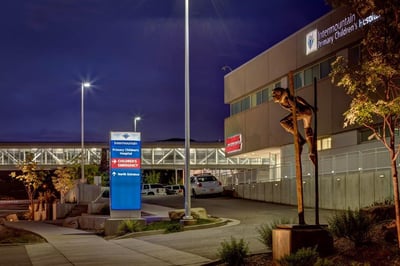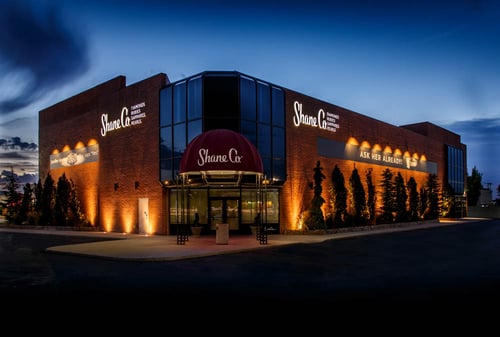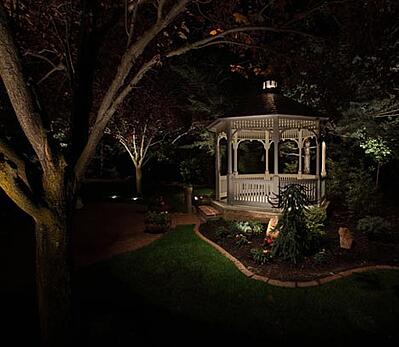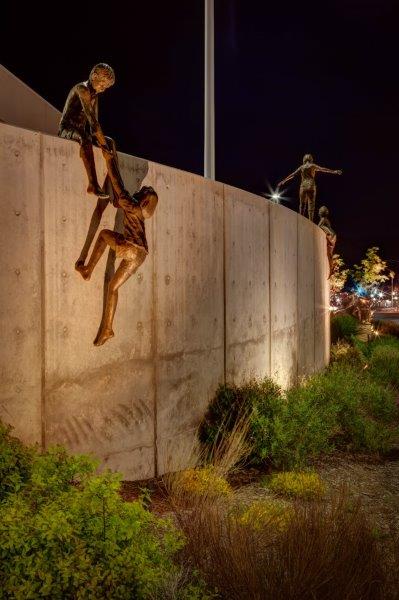How to light a commercial property

When I get a call from a commercial property owner, it’s not because they don’t have lights. They have lights — it’s required by city ordinances.
But are they pretty? Not usually.
A business may have street lights that illuminate the property in a functional way.
But a commercial property’s outdoor lighting should go beyond basic.
It’s the customer’s first clue to the environment inside.
It should impress. Outdoor lighting should reflect the care and attention to detail of the business owner inside.
That’s where a professional landscape lighting designer comes in. We provide curb appeal, beauty, ambiance, and artistry.
We provide the “aah.”
How? We’re glad you asked.
Lighting beyond the basics
When commercial properties such as shopping centers, country clubs, spas, insurance offices, or boutiques are built, the architects design the lighting. Then the electricians come in and install it.
They typically take care of the practical lighting.
They light the signage, the parking lot, the pathways or steps leading to the business. They handle the safety and security lighting.
But details like curb appeal, ambiance, and artistry are usually left in the dark. And those are exactly the elements that draw customers to a business.
A professional landscape lighting designer has the skill and techniques to light a commercial property so it’s not just functional, but beautiful.

First things first
Sometimes we’re called in to light a commercial property several years after it opened.
The first thing we do is make sure all that functional lighting still works.
If existing path lights have been damaged by lawn equipment, kids on skateboards, or heavy foot traffic, we might install sturdy, upright bollard lighting.
The light source is hidden inside the cap of the fixture, so there’s no glare.
If any landscape lighting was installed years ago, it probably needs adjusting. Trees will be taller and plants more established.
Tricks of the trade
A professional landscape lighting designer is a stickler about detail.
For instance, it’s important to take note of the color temperature of the commercial property’s existing lights before adding artistic landscape lighting. You don’t want a strong contrast between the two — you want the lighting to blend.
Composition is another huge part of the job. If we’re lighting a shopping center, we don’t just light the Williams-Sonoma and Victoria’s Secret storefronts. We light the dark spaces in between, so the light directs your eye easily from one spot to the next.
We know that simply adding more light doesn’t make everything better. Too much light installed in the wrong spot can cause uncomfortable glare. We use glare shields and “eyelids” so the light goes where it’s supposed to go.
Highlight your outdoor landscaping

If your commercial property includes trees, garden beds, sculptures, fountains, or waterfalls, why not highlight their beauty at night?
A combination of uplighting, downlighting, and moonlighting can beautifully accentuate your outdoor features and add automatic drama.
A light fixture is placed high up in a tree and angled downwards.
The effect? Moonlight shining down through the branches. It feels natural and creates a lovely effect as the leaves and branches make shadow patterns on the ground.
Consider moonlighting for any commercial property that features evening entertaining.
Artistic uplighting or downlighting can provide just the right illumination to make your customers take as much notice of your landscape’s features at night as they do during the day.
Professional lighting also provides a calm, soothing effect for commercial properties that cater to people when they’re at their most vulnerable state.
Wash lighting for walls and benches
If your commercial property includes structural walls to block out street noise, they can become part of the atmosphere when lit with soft washes of light.
If you spotlight statues, trees, or other elements and there’s wall space in between, washing the walls with soft light draws your eye across the scene, eliminating any hot spots you’d get by only lighting the landscape elements.
We often use downlighting under outdoor benches and seating walls to cast subtle lighting along pathways and patios. Not only does it cast a welcoming glow, it also offers an element of safety for your customers walking through.
Why should you call a professional landscape lighting designer?

Maybe you had commercial landscape lighting installed years ago when your business first opened.
But landscapes change, plants and trees grow, and your original lighting may no longer do the best job of accenting your landscaping features.
The lighting outside your business is as important as the lighting inside. Skillfully installed, artistic landscape lighting will draw customers to your door and show them you care about their first impression of your business.
A professional landscape lighting designer is a stickler about detail.
We pay attention to composition and glare.
Leave your commercial landscape lighting to us
If you decide your business needs artistic, professional commercial landscape lighting, we’d love to hear from you. Give us a call at (801) 440-7647 to schedule a free consultation, or fill out our simple contact form.
Located in Sandy, Landscape Lighting Pro of Utah serves customers throughout Utah’s residential areas, including Salt Lake City, Park City, Draper and Holladay. Our outdoor lighting portfolio includes projects from Salt Lake County and Utah County, to Davis County and Summit County — and beyond.
Salt Lake City (Midvale)
801-440-7647
St. George
435-932-6627
©2024 Landscape Lighting Pro